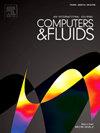将迭代正则化高斯-牛顿法应用于计算流体力学中的参数识别问题
IF 3
3区 工程技术
Q3 COMPUTER SCIENCE, INTERDISCIPLINARY APPLICATIONS
引用次数: 0
摘要
场反演和机器学习是计算流体动力学(CFD)的一个活跃研究领域。利用这种方法可以获得给定湍流模型的闭式修正,从而改进预测结果。其基本方法是在 RANS 方程系统中插入一个参数,并以某种方式确定该参数,例如,与使用原始方程组获得的参数相比,可以更好地近似给定的压力分布。本文的目标有两个。首先,通过数值论证,说明这类问题可能存在严重的求解困难。第二部分将介绍一种直接重建湍流粘度场的方法,并举例说明。使用迭代正则化高斯-牛顿法(IRGNM)来实现。还介绍了有限体积法的问题适应规范的构建。最后,展望了如何利用这种方法来修改或改进湍流模型,以便不仅考虑一个测试案例,而且考虑更多的测试案例。本文章由计算机程序翻译,如有差异,请以英文原文为准。
Application of the iteratively regularized Gauss–Newton method to parameter identification problems in Computational Fluid Dynamics
Field Inversion and Machine Learning is an active field of research in Computational Fluid Dynamics (CFD). This approach can be leveraged to obtain a closed-form correction for a given turbulence model to improve the predictions. The fundamental approach is to insert a parameter into the system of RANS equations and determine it in a way such that, for example, a given pressure distribution is better approximated compared to the one obtained with the original set of equations. The goal of this article is twofold. Numerical arguments are presented that these kinds of problems can be severely ill-posed. In the second part, an approach is presented to directly reconstruct the turbulent viscosity field along with an example. The Iteratively Regularized Gauss-Newton Method (IRGNM) is used for a realization. The construction of a problem-adapted norm for a finite volume method is presented. Finally, an outlook is presented on how this approach can be used to possibly modify or improve turbulence models such that not only one, but a larger number of test cases are considered.
求助全文
通过发布文献求助,成功后即可免费获取论文全文。
去求助
来源期刊

Computers & Fluids
物理-计算机:跨学科应用
CiteScore
5.30
自引率
7.10%
发文量
242
审稿时长
10.8 months
期刊介绍:
Computers & Fluids is multidisciplinary. The term ''fluid'' is interpreted in the broadest sense. Hydro- and aerodynamics, high-speed and physical gas dynamics, turbulence and flow stability, multiphase flow, rheology, tribology and fluid-structure interaction are all of interest, provided that computer technique plays a significant role in the associated studies or design methodology.
 求助内容:
求助内容: 应助结果提醒方式:
应助结果提醒方式:


